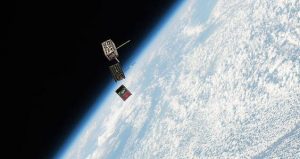
A small spacecraft (or SmallSat) can range in size from a postage-stamp (under an ounce) up to the size of a refrigerator (about 400 pounds). The variety of sizes offers spacecraft capabilities tailored to specific science instruments, exploration sensors or technology demonstrations. (Credit: NASA)
NASA introduced the Small Spacecraft Systems Virtual Institute (S3VI), hosted at NASA's Ames Research Center in Moffett Field, Calif., to leverage the growing small spacecraft (i.e., SmallSat) community, promote innovation, identify emerging technology opportunities, and provide an efficient channel for communication about small spacecraft systems with industry, academia and other government agencies.
NASA sees enormous benefits from investing in research and technology development in small spacecraft systems, such as propulsion, that will be essential in advancing the commercial space sector, said Steve Jurczyk, associate administrator for NASA's Space Technology Mission Directorate (STMD).
STMD established the Small Spacecraft Technology Program in 2011 to develop and demonstrate the unique capabilities of small spacecraft to support science, exploration and space operations. The Science Mission Directorate (SMD) and the Human Exploration and Operations Mission Directorate (HEOMD) each are using small spacecraft for a range of activities: earth and space science measurements to help understand our environment; investigations of microgravity effects on organisms to enable the safe exploration of space; and robotic precursors to maximize the productive use of space.
The S3VI will coordinate with key activities such as STMD's Cube Quest Challenge and HEOMD's CubeSat Launch Initiative. These efforts will continue to offer opportunities for university students and industry to fly small spacecraft as auxiliary payloads on NASA launches.
The S3VI will provide the first one-stop shop for technical knowledge in the rapidly burgeoning small spacecraft technology fields, said Jay Bookbinder, director of programs and projects at Ames. This will result in more-efficient development efforts and enable smaller vendors to compete more effectively in this market.

